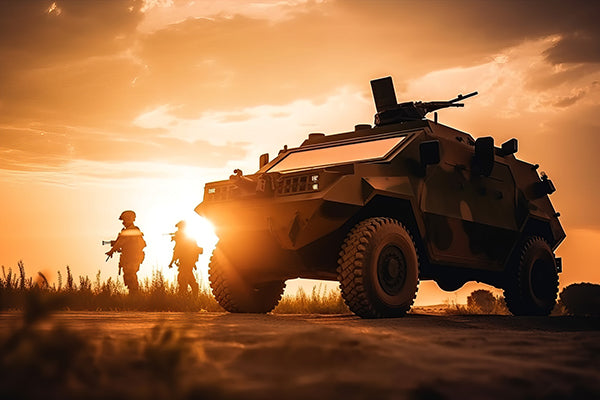
By Benjamin Nigl, Senior Account Manager
Introduction
The landscape of modern warfare is undergoing a profound transformation with the integration of cutting-edge technologies, and at the forefront of this evolution are autonomous military vehicles. Datalogging, a seemingly inconspicuous yet indispensable technology, plays a pivotal role in shaping the capabilities and effectiveness of these autonomous marvels. In this blog post, we delve into the critical role of datalogging in autonomous military vehicles and its impact on the future of defense strategies.
Securing Strategic Advantage
Datalogging in autonomous military vehicles involves the systematic recording and storage of a vast array of data, ranging from sensor inputs and environmental conditions to the vehicle's decision-making processes. This wealth of information serves as a strategic asset, enabling military planners to analyze and optimize the performance of autonomous systems in a variety of operational scenarios.

Enhanced Situational Awareness
One of the key advantages of datalogging in autonomous military vehicles is its contribution to situational awareness. The continuous recording of sensor data, such as radar, lidar, and infrared, provides a comprehensive and real-time understanding of the battlefield environment. This wealth of information empowers military commanders to make informed decisions, adapt tactics, and respond effectively to dynamic and evolving threats.
Operational Analysis and After-Action Review
Datalogging plays a crucial role in post-mission analysis and after-action review (AAR) in military operations. The recorded data allows military strategists and analysts to reconstruct and review the events leading up to and during a mission. This retrospective analysis provides valuable insights into the performance of autonomous military vehicles, aiding in the refinement of tactics, training, and the enhancement of overall mission effectiveness.
Adaptability and Continuous Improvement
Autonomous military vehicles are subjected to a wide range of operational conditions, from arid deserts to dense urban environments. Datalogging enables military engineers to understand how these vehicles navigate and respond to diverse challenges. This real-world data serves as a foundation for continuous improvement, allowing for the refinement of algorithms, navigation systems, and decision-making processes to enhance adaptability in various terrains and scenarios.
Reducing Soldier Exposure to Risks
The deployment of autonomous military vehicles equipped with advanced datalogging capabilities contributes to the reduction of risks faced by military personnel. By assuming roles such as reconnaissance, surveillance, and logistics, these vehicles enable soldiers to operate at a safer distance from potential threats. Datalogging facilitates the analysis of vehicle behavior in hazardous conditions, ensuring that autonomous systems can reliably execute missions while minimizing human exposure to danger.

Challenges and Ethical Considerations
While the benefits of datalogging in autonomous military vehicles are clear, there are challenges and ethical considerations that must be addressed. Data security, privacy concerns, and the potential for misuse of collected information are critical issues that demand careful attention. Striking a balance between operational effectiveness and ethical use of technology is essential for the responsible deployment of autonomous military systems.
Conclusion
Datalogging stands as a linchpin in the realm of autonomous military vehicles, shaping the future of defense strategies and ensuring a strategic edge in modern warfare. Its role in enhancing situational awareness, facilitating post-mission analysis, and driving continuous improvement underscores its significance in the development and deployment of these advanced military technologies. As datalogging capabilities evolve, so too will the effectiveness and adaptability of autonomous military vehicles, redefining the landscape of defense in the 21st century.
Click the buttons below to share this blog post!

By: Jaan Mannik – Director of Commercial Sales
The term AI, or Artificial Intelligence, is everywhere nowadays and has quietly woven itself into the fabric of our daily lives. It powers the recommendations we see on streaming platforms, the navigation apps that guide us through traffic, and even the virtual assistants that answer our questions in seconds. From optimizing energy use in smart homes to predicting market shifts in finance, AI has become the invisible engine driving convenience, efficiency, and insight across industries.
In manufacturing, AI-driven robots collaborate with humans to streamline production. In agriculture, machine learning models monitor crops, forecast yields, and conserve resources. Retailers use predictive analytics to anticipate consumer needs before customers even express them. The reach of AI is no longer confined to futuristic labs, it’s in our phones, vehicles, and cities, constantly learning and adapting to serve us better.

OSS PCIe-based products deliver critical advantages for modern military sensor systems by enabling real-time data acquisition, processing, and transmission in rugged, mission-critical environments. These benefits stem from their ability to support high-bandwidth, low-latency interconnects, modular scalability, and environmental resilience, all of which are essential for today’s advanced military platforms.

Companies today are being asked to do more with data than ever before. Bigger AI models, faster insights, and workloads that don’t stay in one place, it’s a lot to keep up with. Traditional infrastructure just isn’t built for this kind of speed and flexibility.
The answer isn’t about throwing more hardware at the problem. It’s about building smarter, more agile infrastructure that adapts as demands change. And that’s where scale-out and increasingly, a blend of scale-out and scale-up come into play.